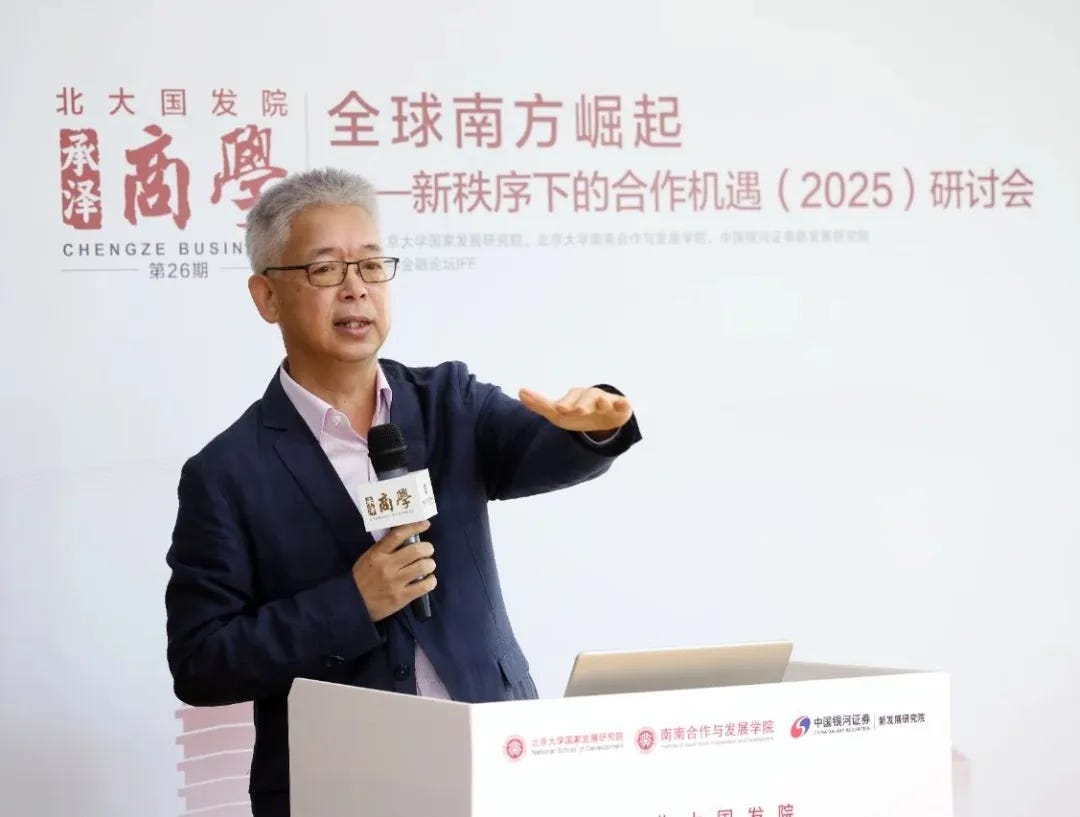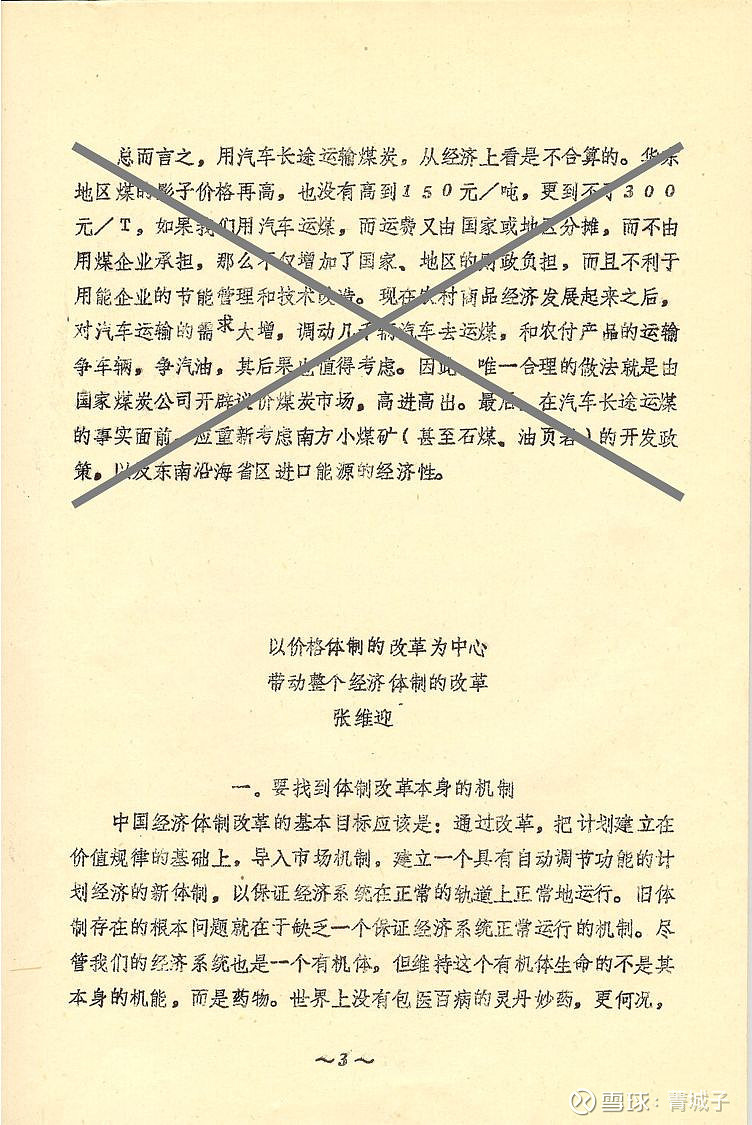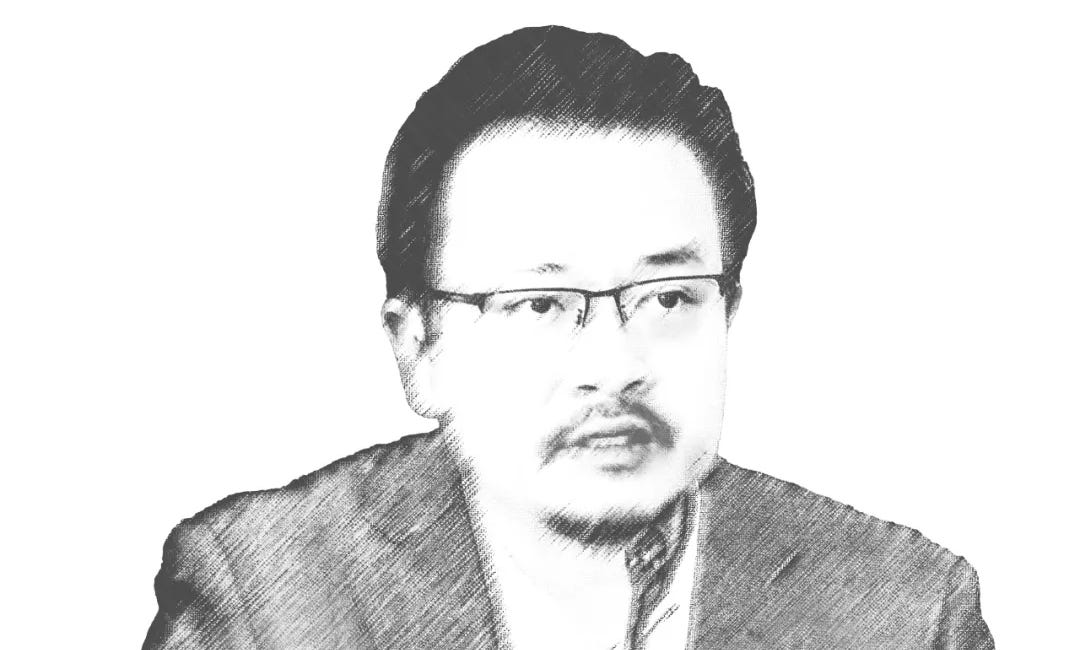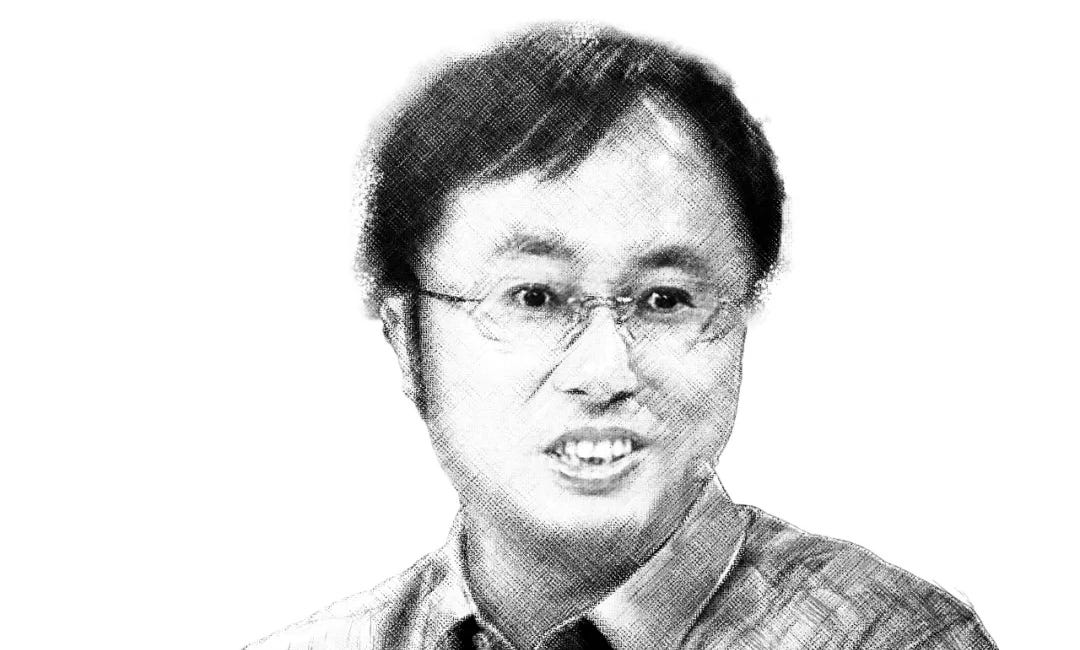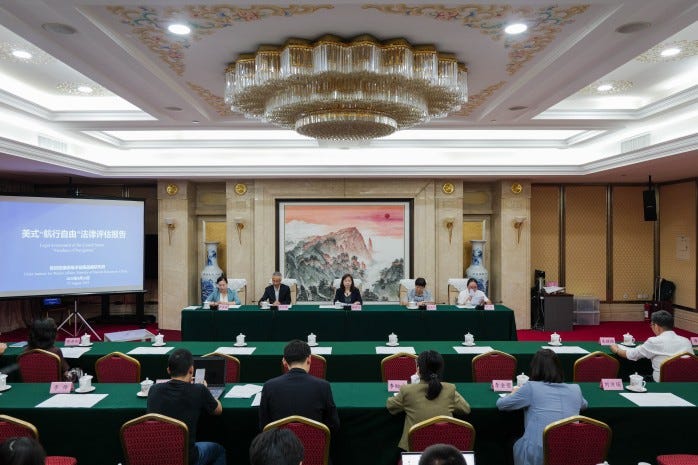Huang Yiping on China’s role in the Global South
Dean of PKU's Institute of South-South Cooperation and Development advises China to provide intellectual support to the Global South, stressing tailored policies over direct emulation.
Huang Yiping, Boya Distinguished Professor, Dean of the National School of Development (NSD), Dean of the Institute of South-South Cooperation and Development (ISSCAD) at Peking University, recently argued that China’s success model cannot be directly replicated by Global South countries and encouraged Global South students to adopt China’s pragmatism rather than policy frameworks.
The speech was made at an NSD seminar on May 21 and is available on the NSD’s official WeChat blog.
—Yuxuan Jia
全球南方国家正面临哪些新挑战?
What Are the New Challenges Facing the Global South?
The term “Global South” generally refers to developing countries in Africa, Latin America and the Caribbean, the Pacific Islands, and Asia, covering vast geographic areas. Despite generally lower income levels, the Global South plays a significant role in the global economy.
Many nations in the Global South are currently grappling with challenges to income and economic growth, with many caught in the “middle-income trap” and others still facing persistent poverty. Since the Industrial Revolution, only a handful of countries have achieved sustained prosperity. Today, the Global South stands as the frontier of economic development. These challenges are both longstanding and severe, and they will continue to be among the most pressing concerns for the Global South.
In addition to these issues, new technologies, particularly artificial intelligence (AI), are introducing many new challenges while presenting new opportunities. Whether this technological revolution will narrow or widen the gap between the Global North and South remains uncertain for now. Take international trade as an example: traditionally, countries find their place in the international division of labour based on comparative advantage. As labour costs rose in advanced economies, labour-intensive industries shifted outward, first from Japan to the Asian Tigers, then to China, and later to Southeast and South Asia, potentially continuing to other countries and creating new development opportunities. This trajectory exemplifies the “flying geese paradigm”: as costs rise in advanced economies, industries upgrade and relocate, enabling other countries to climb the development ladder in stages.
However, as AI advances, technological change may ease the pressure of rising labour costs. This raises new questions: Will labour costs remain a primary driver of the global relocation of labour-intensive industries? What does this shift imply for developing countries? For now, the answers are uncertain. Can labour-intensive industries still follow the traditional path of geographic relocation? If not, what comes next?
Many scholars of global AI development highlight the challenge of inequality. On one hand, low-income economies, constrained by weak digital infrastructure, lack the capacity for AI innovation and deployment, risking further marginalisation in this new technological wave. On the other hand, a KPMG survey shows that people in developing countries report far higher regular use of AI than in developed countries (80% vs 58%). Can developing countries turn adoption into tangible gains—and how quickly? This may signal a leapfrogging opportunity for the Global South.
In short, whether AI will narrow or widen the gap between the Global North and South remains an open question. These dynamics warrant close monitoring and deeper research.
Another significant challenge is the so-called “Kindleberger Trap.” The term originally referred to the Great Depression of the 1930s, when the United States had surpassed Britain as the world’s largest economy but did not assume responsibility for providing global public goods, leaving international affairs without clear leadership. Today, the global economy again faces the risk of such a leadership vacuum.
Many developing countries, including China, previously developed by benefiting from participation in the international division of labour, seizing opportunities in global trade and investment. The United States was a principal advocate and promoter of globalisation, which brought substantial gains to the U.S. while also expanding opportunities for many in the Global South. However, this pattern may now be reversing: the United States, long pivotal in supporting global public goods, seems to be retrenching from some of its international commitments. If this trend continues, who will uphold the international economic order? And what will this shift in the global environment mean for the development prospects of the Global South? These are critical questions that deserve deep reflection.
Therefore, the Global South is indeed facing a range of both old and new challenges. Some of these challenges are long-standing, while others are newly emerging. Regardless of the nature of these challenges, it is clear that countries in the Global South must unite in their efforts, aiming not only to secure better development opportunities but also to play a more significant role in global affairs.
What Role Can China Play in Supporting the Development of the Global South?
What contributions can China make to foster cooperation and development within the Global South? To begin, let me introduce the work of the Institute of South-South Cooperation and Development (ISSCAD) at Peking University. The establishment of ISSCAD was announced by President Xi Jinping during the 70th anniversary of the United Nations in 2015, and it was officially founded at Peking University in 2016. The Institute is approaching its 10th anniversary next year.
Recently, an ISSCAD delegation visited Tanzania and South Africa, where they conducted training programs for local government officials and engaged in wide-ranging discussions with government officials, think tank experts, and both Chinese and foreign enterprises. The delegation also launched a series of events to commemorate the Institute’s 10th anniversary. To date, the Institute has trained nearly 500 participants from close to 80 countries, primarily mid- to senior-level government officials. These alumni are equipped with advanced knowledge of national development and are well-versed in China’s development experience. Many have gone on to assume influential roles in their respective countries.
From the outset, ISSCAD has set a clear focus on three core objectives:
Developing talent for developing countries, with a particular emphasis on government management;
Conducting internationally advanced research on national development;
Serving as a global platform for dialogue on international governance issues.
Professor Justin Yifu Lin, the Founding and Honorary Dean of ISSCAD, once said that the mission of the Institute is to establish a “Belt and Road Initiative” on the intellectual dimension. While the Belt and Road Initiative traditionally focuses on infrastructure development and financing for developing countries, ISSCAD’s emphasis is on providing intellectual support for these countries and regions, offering policy philosophies, fostering talent development, and facilitating think tank collaboration.
Reflecting on ISSCAD’s work to date, though still limited, I would like to share three brief perspectives or takeaways:
The relevance of China’s economic development experience for the countries of the Global South;
How China can collaborate with the Global South to confront the challenges arising from shifting global economic dynamics;
New approaches and strategies China could adopt in supporting the development of the Global South and strengthening its cooperation with these countries and regions.
I. The relevance of China’s experience for the Global South
There are several well-established theoretical frameworks and perspectives in economics on how to promote economic development. The most famous is the “Washington Consensus,” a set of policy guidelines formulated by international organisations based in Washington, including the International Monetary Fund (IMF), the World Bank, and the U.S. Treasury Department, designed to guide and assist developing countries in conducting economic reforms and boosting economic growth. Based on neoliberalism, the Washington Consensus advocates for economic reforms through marketisation, privatisation, liberalisation, etc., to drive economic growth.
It is said that John Williamson of the Peterson Institute for International Economics, the coiner of the term “Washington Consensus,” initially introduced his ten key measures, intending to have international organisations endorse them. However, over time, the Washington Consensus came to be viewed as the policy framework promoted by international organisations for developing countries, focusing on reducing government intervention and promoting trade and financial liberalisation. The IMF and World Bank did, in fact, adopt these principles as key conditionality for providing loans or aid to developing nations.
However, in hindsight, the implementation of this policy framework has not been as successful as expected. During the Asian Financial Crisis of the late 1990s, many Asian countries expressed resistance to these guidelines. Objectively speaking, the principles behind the Washington Consensus are not necessarily wrong, but the key issue lies in their practical application. The Washington Consensus essentially summarises the successful experiences of developed countries, yet it lacks the tailored thinking and design needed to apply it effectively in developing countries. While the framework has some rational basis, its execution proves challenging, as the real difficulty lies in adapting the idealised institutional model to the specific realities of developing nations.
For example, the principles advocated by the Washington Consensus, such as small government, big market, and strict market discipline, do seem reasonable. However, if the market mechanism itself is still underdeveloped, one can easily predict the consequences of fully liberalising it. These principles are not inherently flawed, but can they be effectively implemented in developing countries? Among the countries that have fully adopted the Washington Consensus, how many have achieved significant economic success? After researching widely on this matter, it seems that only Chile stands out as a relatively successful example.
In contrast, China has achieved impressive economic growth over the past few decades. It is worth noting that some of China’s policy measures have often been criticised by economists, with the central debate focusing on whether there has been excessive government intervention. This debate is not only present in China but also exists in other successful East Asian economies. Professors at ISSCAD and the National School of Development (NSD) have offered their own interpretations of China’s economic success, yet they have not adopted the Washington Consensus framework. Instead, they emphasise the dual-track reform approach.
Scholars at the NSD have also proposed their own economic theories on the reasons behind China’s success. This includes Professor Zhou Qiren’s book What China Has Done Right, Professor Justin Yifu Lin’s The China Miracle, and Professor Zhang Weiying’s 1984 paper on the dual-track pricing reform. These analyses come from different perspectives and sometimes differ, often leading to disagreements and debates. However, when these ideas are examined within the framework of “market and government integration,” some common elements begin to emerge.
For example, Professor Zhou Qiren’s analysis essentially summarises the fundamental direction and changes of China’s economic reform, exploring the country’s reform success from different angles. Regardless of how reform policies were designed or implemented, Zhou emphasises the importance of clearly defining property rights, fostering entrepreneurship, and rediscovering market mechanisms, which form the overarching direction of market-oriented reforms.
Professor Zhang Weiying’s dual-track strategy addresses the “how” of the reform. In moving toward market-oriented reforms, there is the choice between “shock therapy” or “gradual reform.” The core of the dual-track pricing reform mechanism is to gradually open up market pricing while continuously adjusting planned prices. Over time, these two tracks can be integrated to complete the marketisation process. Compared to shock therapy, this strategy’s downside is that it may lead to arbitrage opportunities and the creation of vested interests that resist further reforms. However, its advantage lies in reducing the risk of drastic fluctuations, thereby minimising volatility during the process.
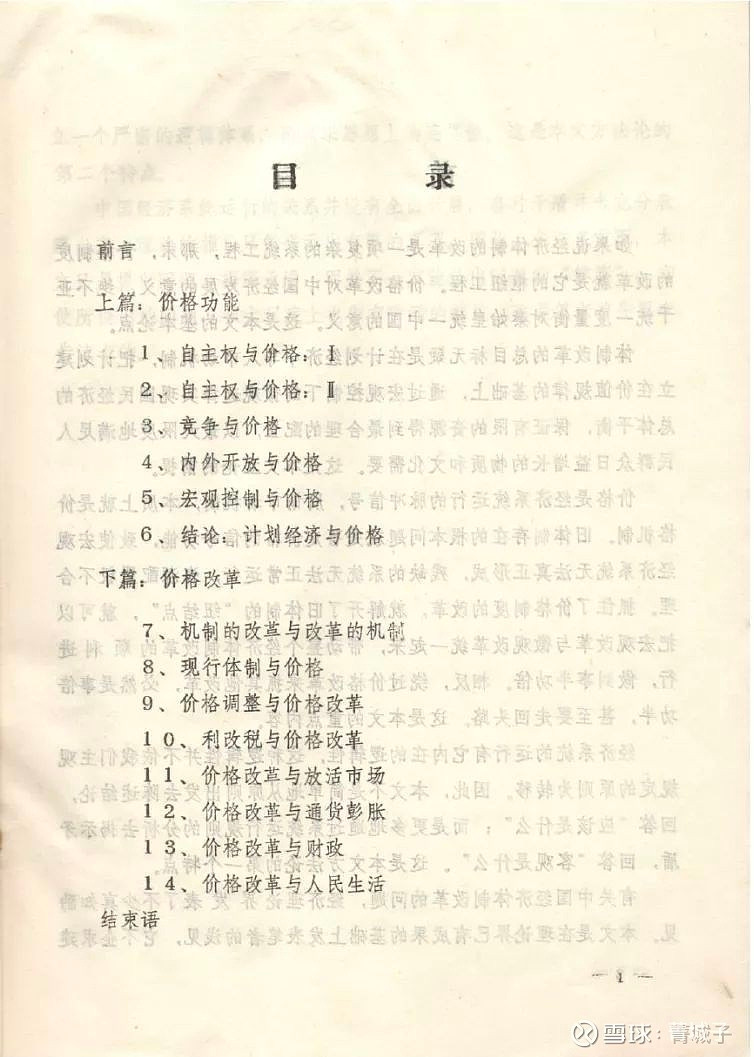
Professor Justin Yifu Lin advocates for the concept of the latecomer’s advantage and comparative advantage, suggesting that countries should develop strategies based on their actual conditions and factor endowments, which also aligns with the broad direction of market-oriented reforms. Lin’s “New Structural Economics” further clarifies the role of government in economic development, which, succinctly put, is the idea of combining effective markets with a proactive government. This proactive government involvement is reflected not only in reform strategies but also in development policies.
Professor Zhang Weiying proposed that by liberalising market prices and gradually adjusting planned prices, the core of the reform should be the dual-track pricing system, which would drive the broader economic system reform.
While their theoretical philosophies differ, the core element shared by all these scholars is pragmatism. This reminds me of the famous quote from Du Runsheng, the father of China’s rural reform: “We must have ideals, but not idealism.” This highlights the importance of considering practical realities and ensuring that policies are feasible when they are formulated.
In contrast, the theory presented by the 2024 Nobel laureates in economics, led by Professor Daron Acemoglu of MIT, posits that inclusive institutions are key to long-term growth. The theory is sound—“good institutions make bad people do good things, and bad institutions make good people do bad things.” However, distinguishing between good and bad institutions is not always straightforward.
The core of China’s experience is “pragmatism.” The key to pragmatic policies is ensuring they are feasible and being results-oriented in implementation—“crossing the river by feeling the stones.” If the path proves effective, continue moving forward; if not, retrace steps and explore new directions. As a result, the policy framework may not always achieve the theoretical optimum at each step, but it is effective and yields tangible outcomes. Du Runsheng’s words, “We must have ideals, but not idealism,” encapsulate the essence of China’s pragmatic reform policies.
While students at the South-South Cooperation and Development Institute study China’s success, they must also consider the relevance of “pragmatism” in addressing the economic challenges of their own countries. China’s approach has been successful, but each country’s context is vastly different. The policies China adopted may not be directly applicable to other developing nations. I am not denying the validity of the Washington Consensus or other economic theories, but I emphasise that effectively fostering economic development requires a pragmatic approach to policy. This is a crucial lesson China can offer to students at ISSCAD. Not every step taken by China was correct, and it may not always be appropriate for countries in the Global South to directly emulate China’s model. However, the concept of pragmatism is vital. It is encouraging that many graduates of ISSCAD have already implemented pragmatic economic policies in their countries, achieving notable success.
II. How China can collaborate with the Global South to address new challenges in the international economic order
The international economic order is undergoing significant changes, and the future direction of U.S. policies remains uncertain. However, it is important to recognise that, regardless of the U.S.’s next steps, the globalisation of trade and investment systems established under its leadership over the past few decades has been beneficial for most countries in the Global South. Nations like Japan, the Asian Tigers, and China have all gained from this system during their rise. For developing countries in particular, the value of this system is clear. Therefore, at the very least, countries with shared interests and positions must collaborate to protect this order.
In fact, there is currently no country capable of replacing the global position of the United States, although countries with shared interests may have the potential to collectively sustain the existing, relatively open, and transparent trade and investment system. While support for this system may be waning in certain countries, those with shared interests can collaborate to explore viable solutions, as this remains in their common interest.
After World War II, during the formation of the international economic order, most developing countries did not play a very active role. Many of them merely followed along and even benefited from certain “concessionary” provisions in the international trade and investment framework. Today, the international system faces the risk of falling into the “Kindleberger Trap.” One way to escape this risk is for the countries of the Global South to take on a more significant role.
There is significant potential to explore how the countries of the Global South can cooperate. Given the political and economic diversity across these nations and their varying interests, even within organisations like the BRICS, each country has different considerations and objectives. Therefore, economic cooperation should aim to find common ground while promoting greater collaboration among Global South countries. For instance, many African countries have recently expressed interest in cooperating with China in resources, investment, and technology. In the future, the economic development of Global South countries may no longer need to rely as heavily on cooperation with the Global North as it has in the past.
III. New approaches China can take in supporting cooperation and development among the Global South
In cooperation with the countries of the Global South, China can explore new approaches and adjust its position.
Traditionally, the Belt and Road Initiative has been understood as a platform for providing financing and infrastructure support, which has indeed played a significant role in the development of Global South countries. ISSCAD has taken a step further by offering intellectual support to the Belt and Road Initiative. In addition to this, other potential initiatives should also be considered, including the “Global South Green Development Plan” that I proposed in 2024.
A Chinese Marshall Plan in the Green Economy Era, Huang Yiping suggests
On May 27-28, 2024, “80 Years after Bretton Woods: Building an International Monetary and Financial System for All” & 2024 Tsinghua PBCSF Global Finance Forum were held in Hangzhou, Zhejiang Province, China.
China has made remarkable achievements in the field of green energy. However, it also faces overcapacity challenges, especially as tariffs and market barriers from Europe and the U.S. complicate the situation. At the same time, many countries in the Global South are in need of a green energy transition, but they face gaps in funding, technology, and products. China could consider offering assistance independently or collaborating with capable, like-minded third countries to help Global South nations advance their green energy transitions.
Currently, the United States frequently adopts protectionist trade policies, which not only disrupt the international trade order but also significantly increase uncertainty in the policy environment. In the face of substantial pressure on foreign trade, the Chinese government should consider implementing macroeconomic measures to “prepare for the storm.” For instance, if trade negotiations between China and the U.S. do not reach an agreement in the short term, China’s exports to the U.S. could face significant risks. These exports account for about 3% of China’s GDP, and the impact could be even larger when considering indirect effects. Addressing such potential risks requires proactive government action.
Traditional macroeconomic policies focus on adjusting monetary and fiscal measures to expand or restrict domestic aggregate demand. However, if expansionary policies do not effectively boost domestic consumption in the short term, they may ultimately exacerbate domestic overcapacity. The “Global South Green Development Plan” offers a new approach to macroeconomic regulation. By providing policy-driven and commercial financing, it supports Global South countries in their green energy transitions. This would directly increase demand for China’s new energy products, serving as a form of “counter-cyclical adjustment” and potentially achieving multiple goals with a single strategy.
Historically, the United States’ “Marshall Plan” helped European countries recover by providing funding, ultimately leading to a win-win situation. Drawing inspiration from this approach, China could consider offering commercial investments, policy-driven financing, and governmental aid to support the green energy transition of Global South countries. This would also open up new market opportunities for China’s green energy industry, creating a win-win or even a multi-win scenario. It can be argued that China, as a major economic power, must address the question of how to develop in tandem with its economic partners. The “Global Green Development Plan” could be a viable initiative that not only aids developing countries but also benefits China’s domestic economy.
The Global South Green Development Plan is just one example, intended to remind us that, beyond infrastructure development, much more can be done to support the growth of the Global South. While infrastructure is crucial—China has an old saying, “if you want to get rich, build roads first”—China’s own development experience shows that building roads alone does not guarantee prosperity. Development is a complex, systemic process, and infrastructure construction alone is not the sole condition for success. Efforts in other diverse areas must also be explored. As for specific approaches, ISSCAD is committed to relevant research and looks forward to collaborating with more partners in these efforts.
Zhao Long on China’s vision for a fairer multipolar order
This is our fifth article translated from the special series in this year’s 16th issue of 世界知识 World Affairs, a Chinese-language magazine published by World Affairs Press under China’s Ministry of Foreign Affairs. The series features contributions from some of China’s “foremost scholars,” according to the magazine, on the theme
Hu Bo: de-hegemonisation of the international maritime order and the risk of regression
This is our fourth article translated from the special series in this year’s 16th issue of 世界知识 World Affairs, a Chinese-language magazine published by World Affairs Press under China’s Ministry of Foreign Affairs. The series features contributions from some of China’s “foremost scholars,” according to the magazine, on the theme
A Legal Assessment of the United States’ “Freedom of Navigation” from Beijing
I’ve long fumed that much of what passes for “research” from certain Chinese institutions is, in reality, little more than glorified op-eds dressed up as scholarship. The dead giveaway? Footnotes—or rather, the lack thereof. And when they do exist, they’re often so perfunctory and unprofessional that you wonder if the authors assume nobody will actually…
Diao Daming: Beijing should be more active to steer China-U.S. engagement
This is our third article translated from the special series in this year’s 16th issue of 世界知识 World Affairs, a Chinese-language magazine published by World Affairs Press under China’s Ministry of Foreign Affairs. The series features contributions from some of China’s “foremost scholars,” according to the magazine, on the theme



